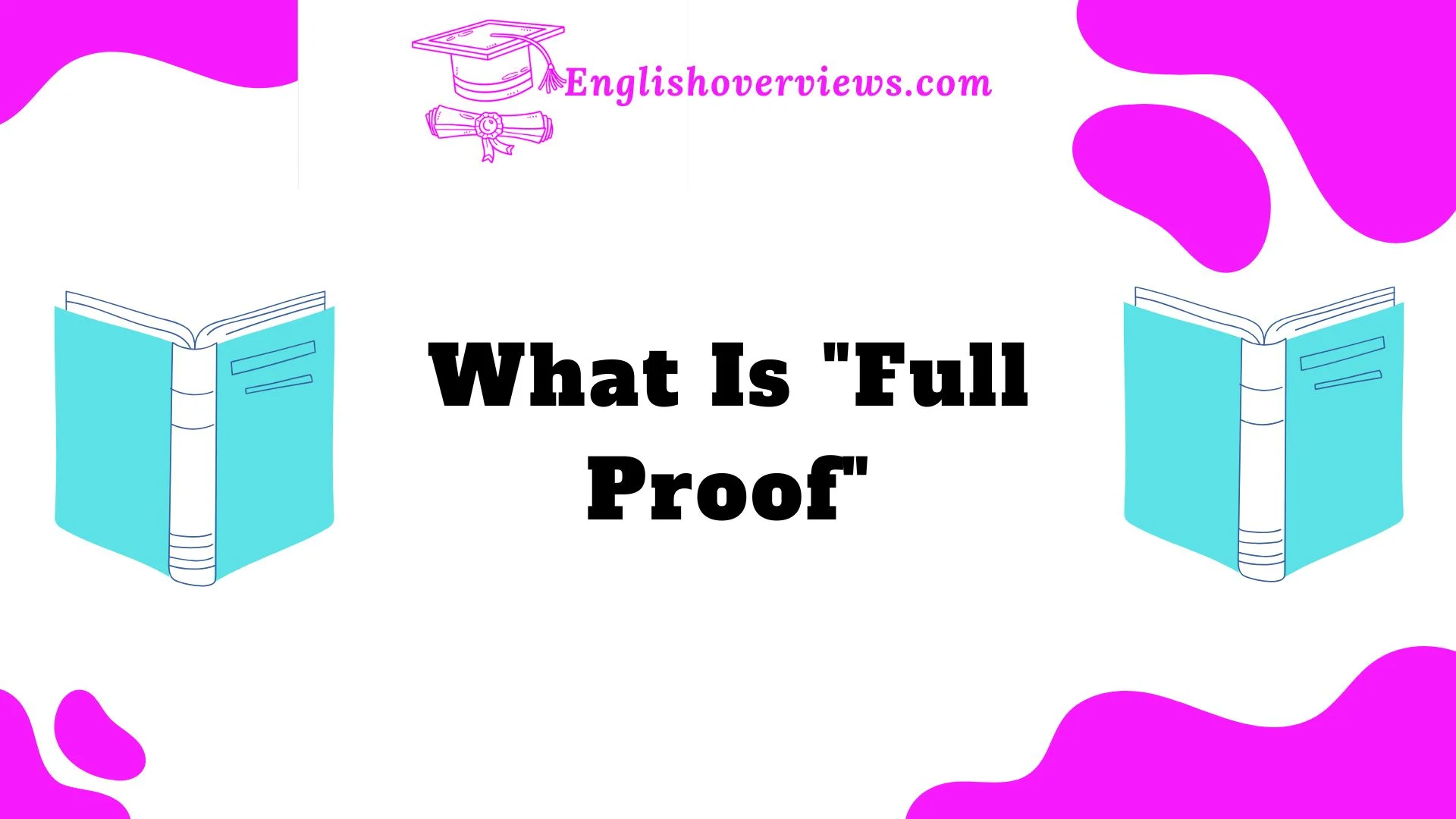The English language is full of phrases and terms that sound alike but mean entirely different things. One such phrase is “full proof.” If you’ve ever wondered whether it’s a valid term or simply a typo for the word “foolproof,” you’re not alone. Many people use these terms interchangeably, often leading to confusion.
But here’s the truth: “full proof” is a real term with a specific meaning, although it’s not as commonly used as “foolproof.” Knowing the difference can enhance your communication skills, especially in professional or technical contexts where precision matters.
In this article, we’ll explore the meaning, origin, and correct usage of “full proof” while also clarifying how it differs from “foolproof.” You’ll also find real-world examples, tables, and practical tips to ensure you use these terms appropriately in your writing and conversations. Let’s dive in!
Understanding the Concept of “Full Proof”
Definition of “Full Proof”
The term “full proof” refers to absolute or complete verification in certain contexts. While it’s often confused with “foolproof,” it has specific meanings in technical and historical usage:
- Alcohol Content Measurement:
In the alcohol industry, “full proof” describes the maximum proof of a spirit. For example, whiskey bottled at “full proof” indicates it retains its natural alcohol content without dilution.- Example: “This bourbon is full proof, bottled straight from the barrel at 125 proof.”
- General Usage:
In rare cases, “full proof” may be used to mean something is entirely verified or completely reliable. However, this usage is less common and often debated in linguistic circles.- Example: “The contract is full proof of the agreement between the two parties.”
Etymology and Origins
The word “proof” originated from the Old French word “prover,” meaning “to test” or “to verify.” Historically, the term was used to measure the strength of alcohol by testing its flammability. If a spirit was “full proof,” it passed the highest standard of verification.
Over time, this technical usage persisted in specific industries, while the phrase “foolproof” emerged later to describe fail-safe systems or methods.
Common Misconceptions
It’s easy to see why people confuse “full proof” with “foolproof.” Here’s a closer look at the most common misunderstandings:
- Similar Sounding Words:
The two terms are homophones, meaning they sound nearly identical when spoken. - Typos in Writing:
“Full proof” is often mistakenly typed instead of “foolproof,” especially in casual writing. - Lack of Awareness:
Many people are unaware that “full proof” has legitimate uses in certain industries, leading to its misuse in general contexts.
The Meaning of “Full Proof” in Modern Usage
In modern language, “full proof” is rarely used outside specific contexts. Its primary associations are with:
- The Distillation Industry
- Definition: Describes spirits bottled at their natural alcohol proof without dilution.
- Example: “This single malt scotch is full proof, retaining its natural strength straight from the cask.”
- Legal and Technical Verification
- Definition: Refers to evidence or documentation that fully proves something without doubt.
- Example: “The certificate is full proof of ownership for the vehicle.”
- Historical Contexts
- Example: “In historical texts, ‘full proof’ was often used to describe absolute evidence or reliability.”
Key Takeaway: While “full proof” has valid uses, it’s highly specialized and should be avoided in casual writing to prevent confusion.
How to Use “Full Proof” Correctly in Sentences
Examples of Correct Usage
Here’s when you can use “full proof” appropriately:
- In Distillation:
- “This bourbon is bottled at full proof for a richer flavor profile.”
- In Legal Verification:
- “The signed document is full proof of the agreement.”
Examples of Incorrect Usage
Avoid these common mistakes:
- Incorrect: “This recipe is full proof and won’t fail.”
- Correct: “This recipe is foolproof and won’t fail.”
- Incorrect: “The plan is full proof; nothing can go wrong.”
- Correct: “The plan is foolproof; nothing can go wrong.”
Foolproof vs Full Proof: Clearing the Air
Defining “Foolproof”
The term “foolproof” means that something is so simple or reliable that even a fool cannot mess it up. It’s commonly used to describe systems, processes, or tools that are easy to use and error-resistant.
Examples of Foolproof Usage
- “This guide is foolproof, ensuring anyone can follow it without mistakes.”
- “The software is foolproof and designed for beginners.”
Comparing “Foolproof” and “Full Proof”
The differences between the two terms can be summarized in this table:
| Term | Meaning | Example |
| Full Proof | Refers to completeness or maximum certainty | “The whiskey is bottled at full proof.” |
| Foolproof | Describes something fail-safe or idiot-proof | “This foolproof method guarantees success.” |
Real-World Case Study
Case Study: Whiskey Distillation
In the whiskey industry, the term “full proof” is used to describe spirits bottled at their natural alcohol content without dilution. For example, Buffalo Trace’s Weller Full Proof Bourbon is marketed as a premium product with intense flavor due to its high alcohol content.
Meanwhile, “foolproof” whiskey brands emphasize easy-to-drink spirits suitable for beginners. The distinction highlights how these terms cater to different audiences and preferences.
Exploring “Full Proof” in Different Contexts
1. Everyday Conversations
In casual conversations, “full proof” is often misused:
- Incorrect: “This plan is full proof and guaranteed to succeed.”
- Correct: “This plan is foolproof and guaranteed to succeed.”
2. Professional Writing
In technical and professional documents, precision is key. Using “full proof” correctly in such contexts can enhance credibility:
- Example: “This legal document provides full proof of ownership.”
3. Popular Media and Literature
Historical texts and niche publications occasionally use “full proof” to describe complete certainty or verification. However, its appearance is rare compared to “foolproof.”
Practical Tips for Avoiding Confusion
To avoid misusing these terms, follow these tips:
- Understand the Context:
- Use “foolproof” for reliability and simplicity.
- Reserve “full proof” for specific technical or legal contexts.
- Double-Check Your Writing:
- Tools like Grammarly can catch errors and suggest corrections.
- Use Memory Tricks:
- Think of “foolproof” as “fool-friendly.”
- Associate “full proof” with “full verification.”
- Practice:
- Write example sentences using both terms to reinforce correct usage.
Conclusion
Mastering the difference between “full proof” and “foolproof” can elevate your communication skills. While “full proof” has niche applications in industries like distillation and legal documentation, “foolproof” is your go-to term for describing reliability and simplicity.
By understanding these terms and their proper usage, you’ll not only improve your writing but also avoid common linguistic pitfalls.
FAQ
1. Is “full proof” a valid term?
Yes, but its usage is limited to specific technical and historical contexts.
2. What does “foolproof” mean?
“Foolproof” means something is fail-safe and reliable, even for someone inexperienced.
3. Can I use “full proof” in casual writing?
It’s best to avoid “full proof” in casual writing unless you’re certain of its context.
4. How can I remember the difference?
Think of “foolproof” as fool-friendly and “full proof” as full verification.
5. Are there tools to help me avoid misuse?
Yes, grammar tools like Grammarly or Pro WritingAid can help catch errors.

English Overviews is a resourceful website dedicated to providing valuable content related to grammar and vocabulary. Muhammad Haroon has made notable contributions, sharing insights on various subjects, including WordPress themes and plugins. The primary goal of the site is to help users improve their English language skills effectively.











